What Is a Node in Blockchain? How It Works Behind the Scenes
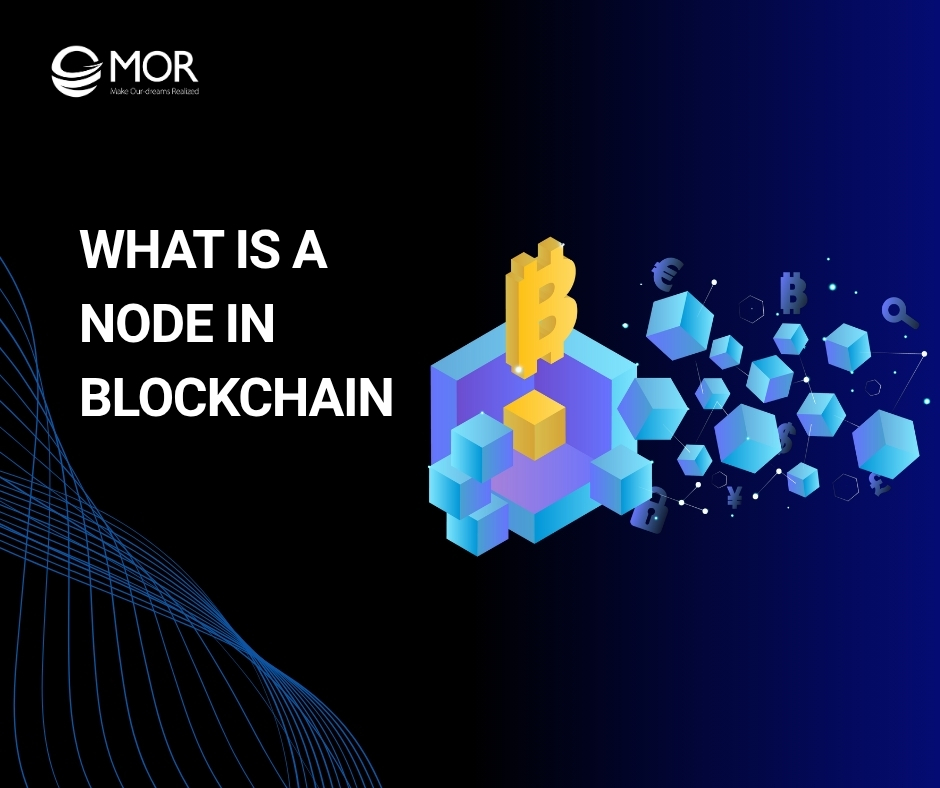
Ever wondered what is a node in blockchain and why it matters to every crypto network’s security and performance? Understanding how blockchain nodes operate is key to grasping what keeps digital transactions transparent, verified, and unstoppable. In this guide, MOR Software explains how blockchain nodes quietly power decentralized systems.
What Is A Node In Blockchain?
What is a blockchain node? To grasp the role of a node in a blockchain, it helps to start with the basics of how a blockchain works. At its core, a blockchain is a decentralized digital ledger shared across a peer-to-peer network. Each block contains encrypted transaction data, permanently stored and linked to the previous one, forming an immutable chain. The devices that store, verify, and distribute these records are known as nodes. On Bitcoin alone, more than 24,000 reachable nodes relay and verify data at any given time, showing how widely the ledger is replicated.
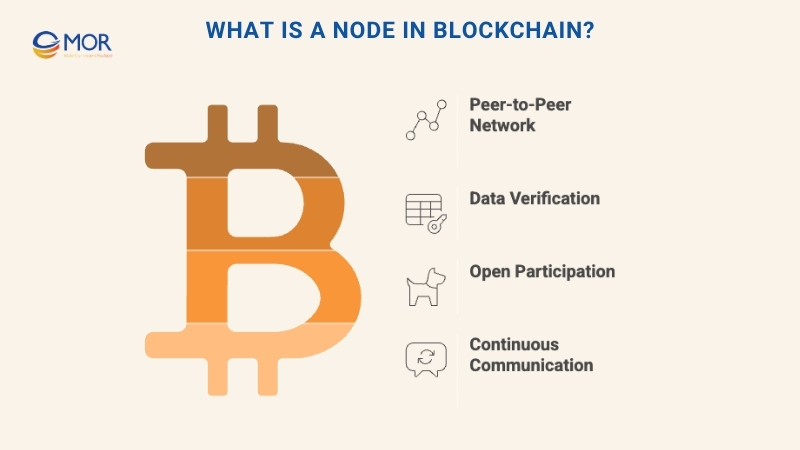
In simple terms, a node in blockchain is a computer or server running the blockchain’s specific software. These blockchain nodes communicate constantly to keep the network consistent and secure. On Ethereum, that coordination today spans over one million active validators with more than 32 million ETH staked to secure the chain.
Till Wendler, co-founder of Peaq, describes it as “a device that keeps the blockchain alive by maintaining its data and protocol.”
Connecting to a blockchain network works much like accessing the internet. Stanislav Zhdanovich, a developer at MetaLamp, compares nodes to browsers, they understand the network’s protocol, allowing them to communicate and exchange data with other blockchain network nodes.
Participation is entirely voluntary. Any user can run a node, contribute to validation, or leave the network at any time without penalty. This open structure is part of what makes blockchain node systems decentralized and self-sustaining, ensuring no single authority controls the entire ledger. Despite this open design, the Bitcoin network has kept roughly 99.988% uptime since 2009, with only two notable interruptions in its history.
How Do Blockchain Nodes Work?
In practice, every blockchain node has three key responsibilities: maintaining the ledger, validating transactions, and ensuring network access. Together, these functions keep a blockchain secure, synchronized, and operational across its decentralized environment.
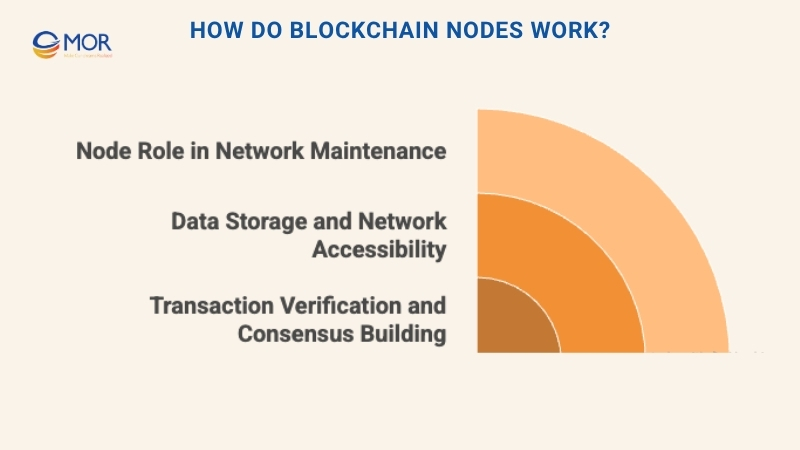
Node Role In Network Maintenance
Nodes act as the backbone of the blockchain. They continuously update and store complete copies of the distributed ledger, recording every transaction in encrypted form. Each node in blockchain ensures the same version of history is preserved across all participants, while also taking in new data as more blocks are added for network expansion. This ongoing maintenance allows blockchain nodes to safeguard the system’s stability and integrity.
Transaction Verification And Consensus Building
When transactions are created, nodes use built-in algorithms to check their validity. They communicate with other peers to accept or reject proposals according to predefined rules. Only verified transactions reach the blockchain, where they’re copied and broadcast across the network. This process relies on consensus mechanisms, protocols that let blockchain network nodes agree on a single version of truth. Once confirmed, all ledgers update instantly, reflecting the same verified data everywhere.
Data Storage And Network Accessibility
Every blockchain node serves as a storage hub, holding the complete record of a blockchain’s data. Whenever someone queries or retrieves information, that request passes through a node. This setup ensures the blockchain remains open, traceable, and transparent to all participants in the system.
Take Polkadot as an example. It’s an open-source, layer-0 blockchain network that provides the foundation for several layer-1 chains, known as parachains. Within this system, collator nodes synchronize parachains with the relay chain, managing both communication and data exchange between them. Each collator operates two full nodes, one for its parachain and one for the relay chain, to maintain smooth interoperability across the ecosystem.
Polkadot also includes other specialized blockchain node types. Validator nodes handle consensus and keep transaction records accurate, while archival nodes preserve the entire network history. Together, they sustain transparency and reliability throughout the platform.
As Peaq’s Till Wendler explains, these communication links make Polkadot powerful: interoperability allows users to connect with numerous decentralized apps across multiple networks. This level of cross-chain collaboration highlights why blockchain nodes matter; they ensure data storage, transparency, and communication that drive the Web3 experience forward.
Why Are Blockchain Nodes Important?
Once you understand “what is a node in blockchain?”, it’s easier to see how every blockchain node forms the backbone of the network. Beyond storing and validating data, nodes preserve the system’s independence, integrity, and resilience. Without them, the entire blockchain would lose its decentralization and reliability.
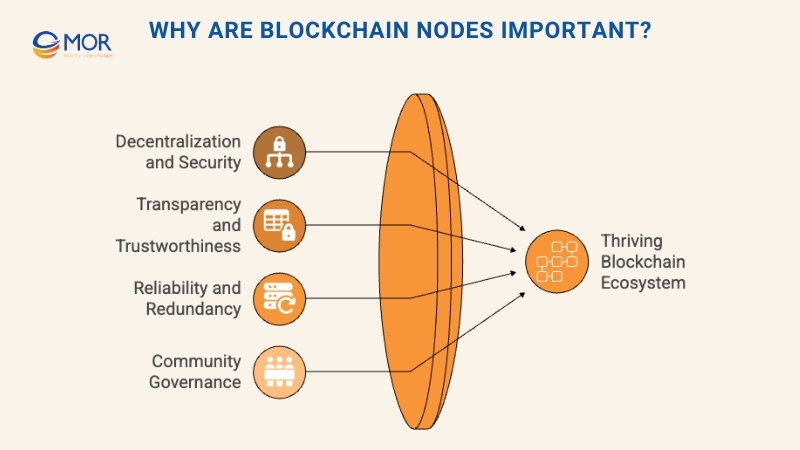
Promoting Decentralization And Security
Nodes distribute data and authority across many participants instead of relying on a central entity. This shared control strengthens the network, making it far less prone to censorship, manipulation, or single points of failure. The more crypto nodes a network has, the harder it becomes for anyone to alter or compromise its records.
For individuals or businesses exploring crypto node investment, running a node is also a way to contribute to network stability while earning long-term returns through participation rewards.
Supporting Transparency And Trustworthiness
Each transaction recorded through a blockchain node is visible and verifiable, which builds transparency. Because every participant can review the ledger’s contents, the system promotes trust among users.
This transparency is now being put to work beyond crypto, as the World Bank’s new FundsChain platform gives project partners real-time, tamper-evident access to how development funds move through programs. This openness is one of the main reasons why nodes in blockchain matters to organizations looking for data integrity and accountability.
Enhancing Reliability And Redundancy
The decentralized nature of blockchain nodes ensures that even if some fail, others continue maintaining the ledger. Multiple synchronized copies prevent data loss and downtime, giving the network continuous reliability. Whether handling payments or managing records, bitcoin node systems and others like it prove that redundancy keeps operations stable and secure.
Enabling Community Governance And Participation
Many blockchain nodes do more than process transactions, they also shape how the network grows. In several systems, nodes can vote on proposals that influence upgrades, policies, or major decisions. This democratic structure ensures the blockchain evolves through community consensus rather than centralized control.
The Dash network is a clear example. Thousands of Dash masternodes participate in governance, historically around 4,800, each bonded with 1,000 DASH to align incentives when voting on features and funding. Similarly, Decred uses a hybrid model that lets stakeholders participate in governance directly through their nodes, combining proof-of-work and proof-of-stake for balanced decision-making. Decred’s design channels the majority of each block reward to proof-of-stake voters, currently 89% of the subsidy, to reinforce on-chain voting power.
Another case is MakerDAO, a decentralized finance platform where holders of the MKR token run nodes and help steer protocol updates. These setups demonstrate what are nodes in blockchain and how they support transparency, shared ownership, and collaboration, allowing users to influence network direction in real time.
10 Main Types Of Blockchain Nodes
There are several types of nodes in blockchain, each serving a specific role in how the network operates. The main blockchain node types descriptions include the following:
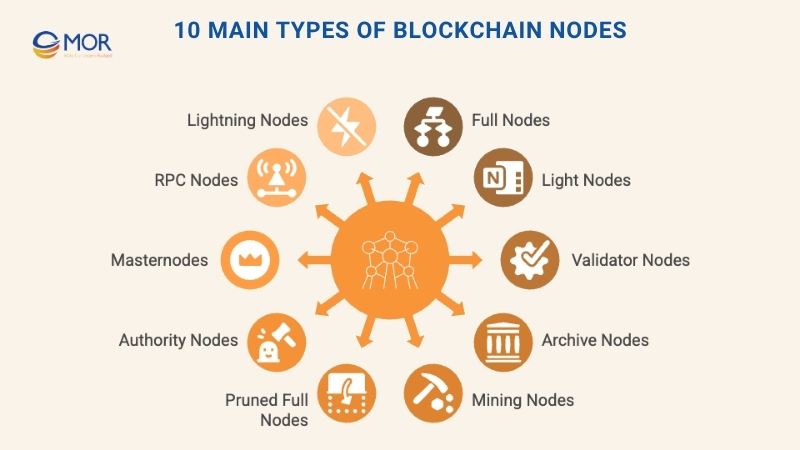
1. Full Nodes
Full nodes act as the foundation of any blockchain network. They store the entire history of transactions and verify every new block that gets added. These nodes follow strict consensus rules, ensuring that all data recorded on the chain remains accurate and untampered.
Validating transactions independently, full nodes strengthen the security and transparency of the network. Their complete ledger copies make it possible to detect inconsistencies, maintaining trust across all blockchain nodes.
2. Light Nodes
Light nodes, also known as Simplified Payment Verification (SPV) nodes, are a streamlined version of full nodes. Instead of holding the full blockchain, they store only block headers containing essential transaction summaries. This design allows them to process operations faster and with less storage.
While light node in blockchain connect directly to the blockchain network nodes, they depend on full nodes to retrieve detailed data when necessary. They’re often used in mobile wallets and lightweight applications where efficiency matters more than complete record-keeping.
3. Validator Nodes
Validator nodes are specialized blockchain nodes that verify transactions and create new blocks within the network. In Proof of Stake (PoS) systems, they are often called staking nodes since participants must lock up a portion of their native cryptocurrency to join the validation process. Their primary goal is to maintain fairness, decentralization, and network accuracy.
If a validator acts dishonestly or fails to follow the consensus rules, it faces penalties known as slashing, which result in the loss of its staked assets. This mechanism ensures that crypto nodes operate responsibly, protecting the blockchain’s overall integrity and trust.
4. Archive Or Archival Nodes
Archive nodes store the complete historical record of a blockchain, including all smart contract states and past transactions. They function as the long-term memory of the blockchain nodes list, preserving every detail since the network’s launch. Because of the massive amount of data they hold, archive nodes require extensive storage and higher maintenance costs.
Still, their value is immense. Developers, analysts, and auditors rely on archival data to conduct detailed reviews, trace activities, or build research-driven applications. Without them, accessing the full history of blockchain nodes systems would be nearly impossible.
5. Mining Nodes
Mining nodes are the core of blockchain networks that use the Proof of Work (PoW) consensus model, such as Bitcoin. These nodes perform the heavy computational work of solving mathematical puzzles to validate transactions and create new blocks. In return, miners receive rewards in the network’s native cryptocurrency.
Each mining node contributes to the blockchain’s security by ensuring that only verified transactions are added to the ledger. Many miners join large pools to combine computing power and share rewards based on their contribution. This cooperative structure keeps blockchain node systems like Bitcoin secure and continuously operational.
6. Pruned Full Nodes
Pruned full nodes operate similarly to traditional full nodes but manage data more efficiently. Instead of storing the complete blockchain history, these nodes retain only the most recent data needed for validation. Once they reach a predefined storage limit, older blocks are automatically deleted to free up space.
This design allows blockchain node operators to participate in network validation without investing in large-scale storage solutions. It’s a practical balance between maintaining the blockchain’s accuracy and keeping hardware costs low, making it ideal for users who want to support the network with limited resources.
7. Authority Nodes
Authority nodes are a form of blockchain node that operate under the Proof of Authority (PoA) consensus model. Instead of relying on computational power or staked tokens, these nodes validate transactions and generate new blocks based on verified identity. The number of authority nodes in a network is usually determined through community or governance voting.
While this setup introduces a certain degree of centralization, it’s often a fair trade-off in cases that demand higher efficiency or regulatory oversight. Enterprise blockchain node types commonly use PoA systems to ensure data accuracy, faster processing, and compliance with industry standards.
8. Masternodes
Masternodes function as specialized full nodes that don’t mine or create new blocks, yet they play a key role in verifying and recording transactions. They also handle advanced network functions like voting on proposals, executing protocols, and managing governance operations.
Individuals or businesses running masternodes receive rewards in native cryptocurrency for maintaining uptime and performance standards. These incentives encourage participation and stability across the blockchain network nodes, keeping the ecosystem active and secure. Masternodes are particularly common in networks like Dash, where they help balance decentralization and structured management.
9. RPC Nodes
RPC (Remote Procedure Call) nodes serve as communication gateways between applications and blockchain networks. They let users and decentralized applications (dApps) send requests to perform actions such as submitting transactions, checking balances, or retrieving specific data.
By handling these external requests, RPC nodes make blockchain network nodes more accessible to developers and end users. They are essential for powering dApps that rely on real-time blockchain interaction, enabling projects to scale and support large volumes of user activity. This type of node bridges on-chain and off-chain environments, forming a foundation for modern Web3 applications.
10. Lightning Nodes
Lightning nodes are designed to reduce congestion on the main blockchain by processing transactions through off-chain payment channels, also known as Layer 2 scaling solutions. These crypto nodes that pay allow users to send multiple transactions instantly and at a much lower cost before final settlement is added back to the main chain.
The use of lightning nodes improves speed and affordability without compromising the blockchain’s overall security. By offloading a large share of simple payments, they free up space for more complex transactions on the main network. This balance of efficiency and security highlights how blockchain nodes continue to evolve to meet real-world scalability needs.
Examples Of Blockchain Nodes
Different blockchains use nodes in unique ways to secure their systems and validate data. Two of the most recognized examples, Bitcoin and Ethereum, demonstrate how these structures support decentralized operation and trustless transactions.
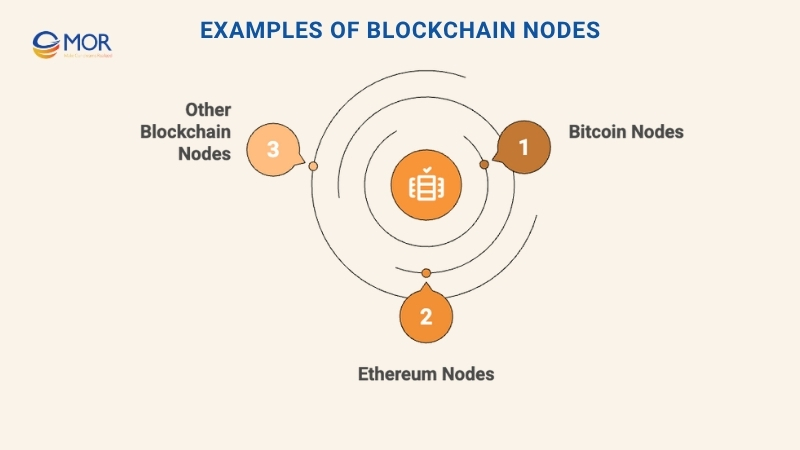
Bitcoin Nodes
Bitcoin nodes are essential to keeping the Bitcoin network decentralized and secure. The system runs on the Proof of Work (PoW) model, where specialized nodes known as miners compete to solve complex mathematical puzzles. When a block is successfully mined, it’s broadcast to other bitcoin node operators across the network for verification. Once validated, the block is added to the blockchain and replicated across all nodes.
This process ensures every blockchain node maintains the same transaction history, eliminating single points of failure and protecting the network from fraud or tampering. The cooperation between miners and non-mining nodes forms a distributed structure that allows Bitcoin to function independently of any central authority.
Ethereum Nodes
Ethereum relies on its nodes to maintain security, verify transactions, and execute smart contracts. Initially powered by Proof of Work, Ethereum has transitioned to the Proof of Stake (PoS) model through the Ethereum 2.0 upgrade. Now, validator nodes stake ETH to be eligible for block validation and earn rewards in return.
Each ethereum node stores a synchronized copy of the blockchain and supports decentralized applications, or dApps, through on-chain computation. The shift to staking has drastically lowered energy consumption and increased scalability across the blockchain nodes list. It also redefined node participation, where efficiency, reputation, and reliability now matter as much as computing power.
Nodes In Other Blockchains
Every blockchain adapts its node structure to match its purpose and consensus model. Whether it’s for speed, sustainability, or scalability, all rely on nodes to secure their ecosystems and validate data across the network.
Solana is known for its performance-oriented blockchain node system, designed to process thousands of transactions per second with minimal fees. Its hybrid Proof of History (PoH) and Proof of Stake (PoS) approach enables extremely fast confirmation times, making it one of the most efficient crypto nodes in the market.
Cardano, in contrast, emphasizes sustainability through its PoS framework. Its nodes play a crucial role in balancing decentralization with energy efficiency, enabling the network to grow while maintaining security and transparency.
Binance Smart Chain (BSC) relies on validator and full nodes to manage high-volume transactions at low cost. Its blockchain node provider structure supports a dual-chain model with Binance Chain, enabling smooth asset transfers and interoperability between platforms.
Across these examples, it’s clear that what is a node in blockchain goes beyond one definition, it’s the engine that powers every transaction, consensus, and connection across decentralized systems.
Security Challenges And Risks Facing Blockchain Nodes
Although blockchain nodes are the cornerstone of decentralized security, they still face several vulnerabilities that can threaten network reliability and trust. Understanding these risks is crucial for maintaining safe and stable blockchain ecosystems.
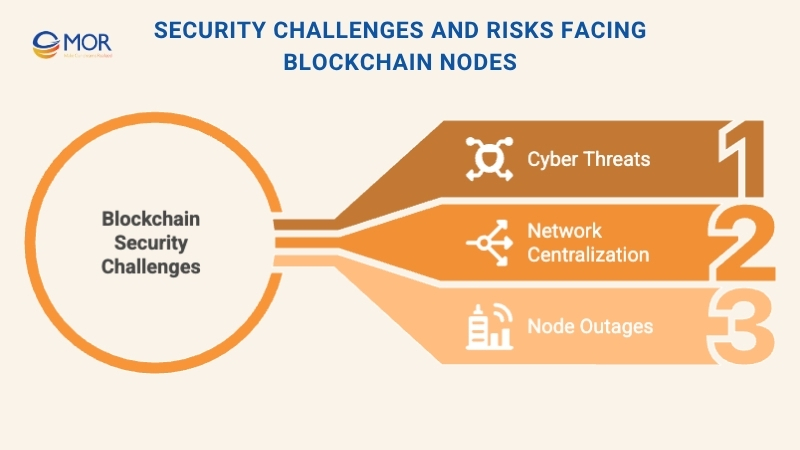
Protecting Nodes From Cyber Threats
Like any online system, nodes are exposed to attacks such as Distributed Denial of Service (DDoS), where malicious actors flood them with traffic to force shutdowns. They can also fall victim to phishing, malware, or other forms of cyberattacks aimed at stealing credentials or corrupting data.
To protect against these threats, node operators must enforce strict security protocols. Common practices include using encrypted communication channels, enabling firewalls, updating software regularly, and monitoring for unusual activity. Decentralized backups and redundancy further safeguard the network from potential data loss. A reliable blockchain node provider will usually integrate these measures into its infrastructure to protect users and maintain uptime.
Risks Of Network Centralization
When too many blockchain network nodes are concentrated under one organization or region, decentralization begins to erode. This concentration makes manipulation, censorship, or coordinated attacks more feasible, weakening trust in the system.
To reduce these risks, networks must promote wide node distribution and encourage participation from individuals, companies, and independent operators worldwide. This diverse structure helps maintain fairness, transparency, and resilience, the same values that define what is a node in blockchain as a secure and democratic technology.
Node Outages And Their Effects On The Blockchain
When a blockchain node fails or goes offline, it temporarily stops validating transactions and syncing data with the network. This can cause short-term delays in transaction processing or block creation. Yet, because blockchain networks are inherently decentralized, the loss of a single node rarely disrupts overall operations. Other nodes continue verifying transactions and maintaining consensus without interruption.
Each blockchain keeps redundant copies of its ledger distributed across hundreds or even thousands of participants. This redundancy ensures that the network remains functional and secure, even if several nodes become inactive.
In rare cases where a large number of blockchain nodes fail simultaneously, users might experience slower confirmations or brief congestion. Still, as long as enough active nodes remain, the blockchain will keep running smoothly and preserve its data integrity. This resilience is what makes what is a node in blockchain technology so dependable compared to traditional centralized systems.
Step-by-Step Guide To Launching Your Own Blockchain Node
Running a blockchain node isn’t limited to developers or large organizations. With proper setup and commitment, any user can help strengthen decentralization and contribute to network security.
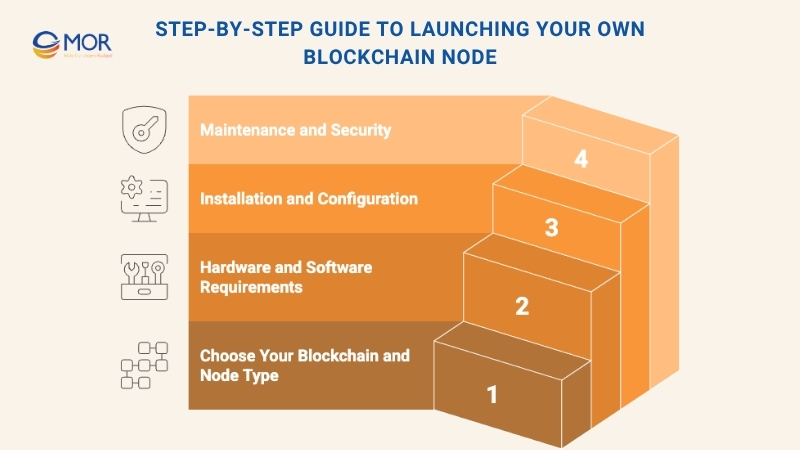
1. Choose Your Blockchain And Node Type
Start by selecting which blockchain you want to participate in. Each has its own software, rules, and hardware requirements. Common choices include major networks like Bitcoin, Ethereum, or Cardano, each offering unique community support and resources.
Next, decide on the node type that suits your goals and capabilities:
- Full nodes give you complete participation rights and store the entire ledger, but they demand more disk space, bandwidth, and processing power.
- Light nodes are easier to maintain, requiring less storage and hardware resources while still supporting basic network operations.
Whichever you choose, your setup becomes part of a global ecosystem that keeps the blockchain transparent, distributed, and secure, illustrating the real power behind blockchain nodes.
2. Hardware And Software Requirements
Hardware
Before launching your blockchain node, make sure your system meets the performance needs of your chosen network.
- Storage: The required space depends on the blockchain’s size. For example, Bitcoin’s ledger can exceed hundreds of gigabytes, while smaller networks or newer chains may use less.
- RAM: A minimum of 4GB is recommended to keep processes stable.
- Processor: Use a modern, multi-core CPU to handle validation and synchronization tasks smoothly.
- Internet connection: A fast, uninterrupted connection is crucial for maintaining up-to-date data and supporting network activity.
Software
- Blockchain client: Download and install the official node software for your selected network, whether it’s Bitcoin Core, Geth (for Ethereum), or another.
- Operating system: Most blockchain network nodes run on Linux, macOS, or Windows, so choose whichever platform you’re most comfortable with.
Proper setup ensures your node runs efficiently, helping maintain decentralization and stability across the system, core principles behind what is a node in blockchain.
3. Installation and Configuration
- Follow official setup guides: Use the blockchain’s official documentation to install and configure your node correctly. These resources provide clear, step-by-step directions specific to each network.
- Enable network connections: Some routers require port forwarding to allow communication with other blockchain nodes. Make sure the necessary ports are open for inbound and outbound data flow.
- Start synchronization: After setup, your node will begin syncing with the blockchain. This process can take hours or even days, depending on the blockchain’s size and your internet speed. Patience is key, the sync ensures your device contains the most recent and verified copy of the ledger.
4. Maintenance and Security
- Stay up to date: Keep your node software updated regularly. New releases often fix bugs, improve performance, and strengthen defenses against threats.
- Protect your system: Secure your node with strong passwords, firewall protection, and encrypted connections. Avoid sharing your IP address or private details online to reduce exposure.
Running a blockchain node responsibly means balancing accessibility with protection. Doing so supports network reliability while safeguarding your contribution to blockchain node ecosystems.
MOR Software – Your Trusted Partner In Blockchain Development
MOR Software is a top Vietnam software outsourcing company specializing in blockchain-based solutions for global clients. With years of experience in software outsourcing and digital innovation, we help businesses transform ideas into secure, scalable, and practical blockchain applications.
Our team of blockchain developers has built custom smart contracts, decentralized apps (dApps), and enterprise-grade tokenization systems that drive transparency and efficiency. We combine deep technical expertise with proven project management frameworks like Agile and Scrum to deliver results that align with each client’s business goals.
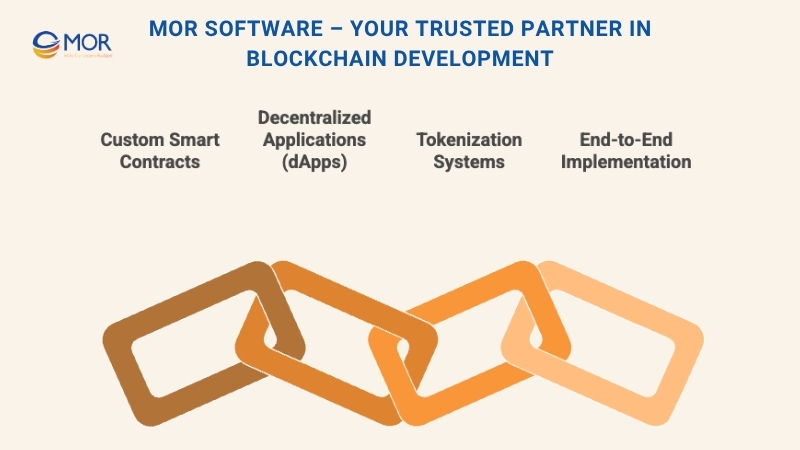
From DeFi platforms and NFT marketplace development company to data security and digital identity solutions, we handle every stage of blockchain implementation, from consulting to full product delivery. At MOR Software, we don’t just build technology, we create long-term partnerships that empower businesses to thrive in the decentralized future.
Contact us to start building your blockchain solution today.
Conclusion
Understanding what is a node in blockchain reveals how these systems stay secure, transparent, and truly decentralized. Every node plays a part in verifying data, maintaining integrity, and keeping the network alive. As blockchain adoption expands, strong technical foundations matter more than ever. MOR Software helps businesses build reliable blockchain solutions that stand the test of time. Ready to explore your own project? Contact us today to bring your blockchain vision to life.
MOR SOFTWARE
Frequently Asked Questions (FAQs)
What are blockchain nodes?
A blockchain node is a computer or device that runs the blockchain’s software and connects to its network. It verifies transactions, stores data, and helps maintain the decentralized structure of the blockchain.
What is the difference between a node and a miner?
Nodes form the basic framework of a blockchain, verifying and sharing data across the network. Miners, on the other hand, are specialized nodes that validate transactions and create new blocks through computational work to earn rewards.
What does a node do?
A node receives, processes, and forwards data within a network. Depending on its type, it can verify transactions, relay information, or act as an intermediary between connected devices like computers, routers, or servers.
What is the role of a node?
Nodes ensure smooth data transmission within the network. They handle routing and switching, directing traffic efficiently so information reaches the correct destination and the network stays synchronized.
Do Bitcoin nodes make money?
Full Bitcoin nodes, which validate all transactions and secure the network, don’t earn direct financial rewards. Only mining nodes receive compensation through block rewards and transaction fees.
How many Bitcoin nodes are there?
The number of active Bitcoin nodes varies but is generally estimated between 50,000 and 70,000 worldwide. These nodes help maintain decentralization and ensure the system’s reliability.
Who owns the blockchain nodes?
No single entity controls a public blockchain. Each node operator contributes to network consensus, collectively ensuring that the system stays secure, transparent, and decentralized.
Why run a blockchain node?
Running a node gives users direct access to the blockchain, improving privacy and security by removing third-party dependencies. Full nodes also strengthen the network by validating and storing all transaction data.
How do blockchain nodes communicate?
Nodes interact using peer-to-peer protocols that let them share information directly. This system keeps all nodes synchronized, ensuring they store identical copies of the blockchain data.
What is a full node in a bitcoin network?
A full node validates every transaction and block independently. It receives data from other full nodes, verifies its accuracy, and then passes it along, helping maintain the network’s integrity.
What is node and why is it used?
Node.js is an open-source JavaScript runtime that enables developers to run JavaScript outside a browser. It’s used for building fast, scalable server-side applications on multiple operating systems.
What is the difference between block and node in blockchain?
A block is a data unit containing confirmed transactions, while a node is a computer that validates and shares those blocks across the network. Nodes ensure all blocks are accurate and consistent across the blockchain.
Rate this article
0
over 5.0 based on 0 reviews
Your rating on this news:
Name
*Email
*Write your comment
*Send your comment
1